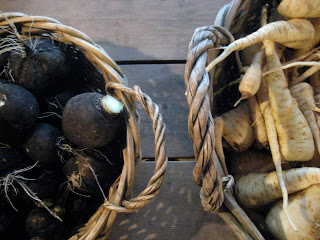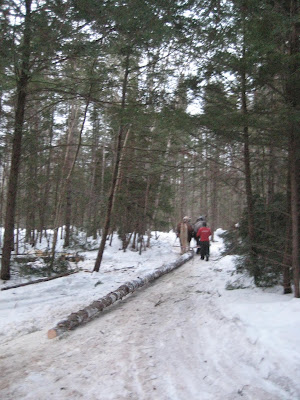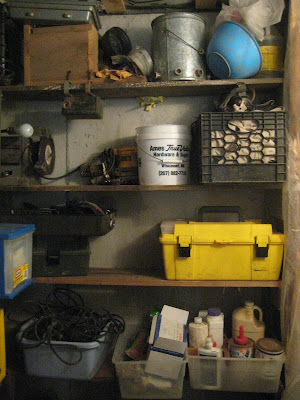I imagined sliding from a warm world of soft darkness, sibling's knobby knees and tender nose my constant company, to the hard cold ground of a dark January morning. Alone. It must not have nursed, because by the time Rich found them in the pasture, around 7:30 am, the sibling was up and about, but the little grey girl was cold and still. He tucked these unexpected arrivals into his coat to keep them warm, and called us on his cell phone.
WHAT?! LAMBS?! Never before have we had lambs in early January. Jeff racked his brain to determine how this happened, I ushered him out the door to get the new momma and her lambs under cover. As I was headed out the driveway, to bring Ruth to school, she commented that dad was taking a sheep out of the truck. In reverse we went back home, fast, to see what was up. The momma and black lamb were fine, but the grey one was very cold and still, lying on a pile of hay in the greenhouse. Jeff thought she wasn't going to make it. I started ordering everyone around, and Jeff suggested he take Ruth to school, and I stay to deal with the lamb situation. Fine. Good.
I stuck my finger in the lambs mouth; jaw stiff and mouth so cold, eyes sealed shut, but she was breathing. I left Rich to watch the black lamb, to make sure it was nursing well, while I raced upstairs with the cold one. I grabbed the closest bucket, filled it with hot tap water, and submerged the still body. I held her there, with only her nose and the top of her head exposed. As I tried to rub life into her, I wondered where her young dreams were taking her. Her consciousness felt so far from this cold body. All she had known up to this point was the soft world inside her mother, the feel of a sibling close by, the sounds of other sheep bleating in another world, and her mother's rhythmic heart beat, chewing, and the turning of her rumen. Then the descent onto this cold earth. Eventually, I took the bucket and lamb downstairs, for Rich to take a shift while I tended to the momma and the other lamb. Jeff returned home, and Leah crouched with me, watching, waiting. Our grey lamb started to stir a little, and I called the vet for advice. Just a little honey on the gums, she said, you can give her nutri-drench if she comes to more. I proceeded to dance the delicate balance of warmth and sugar to recover an animal from hypothermia. Too much warmth before sugar, we'd loose her, and too much sugar before sufficiently warmed leads to the same fate.
She warmed, she wiggled, she parted her lips, she opened her eyes, and, eventually, she "baaad" for her momma! All told, she was in that bucket for about 3 1/2 hours, I had to change the water in it four times, and we took her temperature several times before deeming her warm enough to come out into a towel. I blow-dried her off, and set her in with her mother to carry on with this life in style. She was an eager nurser. They talked to each other in the soft tones a ewe and her lambs reserve for this moment. I was worried that the mother would not bond with this one, after seeing her nearly dead, and then being apart from each other for so long. I had left a little afterbirth on top of the lamb's head, in hopes it would help the mother recognize the lamb as one of her own, and lick it's head off to stimulate the lamb and their bonding. I think it was more the good genetics of Hatchtown Farm's sheep, where this ewe, Annie, is from, than anything else.

It is quite a miracle to witness, the recovery of a lamb from hypothermia. I have only dealt with a hypothermic lamb once before, and the result was not good. I am so grateful that this little life decided to stay with us, to grow bigger, and to experience more warm moments to fill her dreams with. Annie and her two healthy girls are currently living in the greenhouse attached to our house, warmed cold evening by radiant-floor heat, and frolicking outside the greenhouse on sunny days.
It is a happy new Year, indeed.
CSA member Sarah Thompson recommended Ani's Raw Food Kitchen to us, and, while we are are far from being "raw foodists" or "vegans", we are loving many of the recipes it contains. One of our favorites is the "Garden Pate", below. Anna (my sister) first made it, and now it is a house-hold staple. The kids love it! I use the food processor for the whole process, even the "mix well" at the end, so the raisins are blended with the rest. You don't taste the raisins or the almonds, just a sweetness. This makes an invigorating and nutritious spread that feels very fresh in the winter months. The kids like it as a dip (especially with carrots, diakon radish cut like carrot sticks, and pink circles from the misato rose radish); it is also great on sandwiches, wraps, crackers, or wrapped in a little endive leaf.
Garden Pate
from: ani's raw food kitchen; makes 4 servings
1 cup almonds, dry
1 tablespoon grated ginger
2 cloves garlic
1 teaspoon sea salt
3 carrots, chopped
2 stalks celery, chopped (or 1 celeriac, peeled & chopped)
1/4 cup yellow onion, chopped
2 tablespoons extra virgin olive oil
Juice of 1/2 lemon, about 1 tablespoon
1/2 cup raisins
Process almonds into a powder. Empty into large bowl and set aside.
Next, process ginger, garlic, and sea salt to chop up the ginger and garlic. Add carrots, celery, and onion and pulse into small pieces. Add olive oil, lemon juice, raisins, and almond powder. Mix well.
 |
| Our booth at the Brunswick Winter Market |
|
|
January 3 CSA Share
Carrots
Baking potatoes
Garlic
Beets
Onions
Rutabaga
Burdock
Black Spanish radish
Butternut squash
Cabbage
Fermented colored peppers
Frozen green beans
January 18 CSA Share
Carrots
Potatoes
Garlic
Parsnips
Onions
Golden turnip
Celeriac
Misato Rose radish
Confection squash
Endive
Kim chi
Canned dilly beans
Frozen tomatoes
Frozen pesto









































